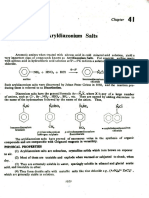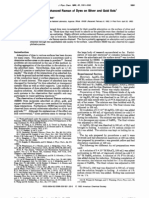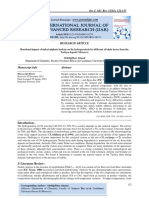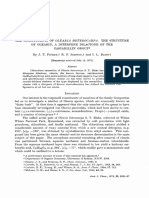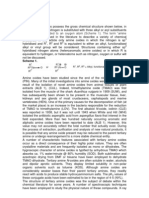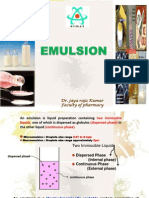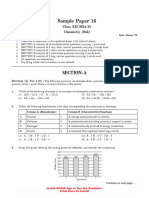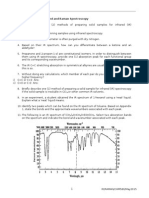0 ratings0% found this document useful (0 votes)
35 views7-Norbornadienyl Carbonium Ion: Department
7-Norbornadienyl Carbonium Ion: Department
Uploaded by
juan joseThis document reports on the preparation and NMR spectrum of the 7-norbornadienyl carbonium ion. Key findings include:
1) Treatment of 7-norbornadiene with thionyl chloride yielded 7-norbornadienyl chloride, which was dissolved in sulfur dioxide and reacted with silver tetrafluoroborate to form the stable 7-norbornadienyl carbonium ion.
2) The NMR spectrum of the ion at -10°C consisted of four distinct peaks in a 2:2:2:1 ratio, consistent with structure I proposed by Winstein and Ordronneau as the non-classical carbonium ion intermediate.
3) The data eliminate any
Copyright:
© All Rights Reserved
Available Formats
Download as PDF, TXT or read online from Scribd
7-Norbornadienyl Carbonium Ion: Department
7-Norbornadienyl Carbonium Ion: Department
Uploaded by
juan jose0 ratings0% found this document useful (0 votes)
35 views1 pageThis document reports on the preparation and NMR spectrum of the 7-norbornadienyl carbonium ion. Key findings include:
1) Treatment of 7-norbornadiene with thionyl chloride yielded 7-norbornadienyl chloride, which was dissolved in sulfur dioxide and reacted with silver tetrafluoroborate to form the stable 7-norbornadienyl carbonium ion.
2) The NMR spectrum of the ion at -10°C consisted of four distinct peaks in a 2:2:2:1 ratio, consistent with structure I proposed by Winstein and Ordronneau as the non-classical carbonium ion intermediate.
3) The data eliminate any
Original Title
story1960
Copyright
© © All Rights Reserved
Available Formats
PDF, TXT or read online from Scribd
Share this document
Did you find this document useful?
Is this content inappropriate?
This document reports on the preparation and NMR spectrum of the 7-norbornadienyl carbonium ion. Key findings include:
1) Treatment of 7-norbornadiene with thionyl chloride yielded 7-norbornadienyl chloride, which was dissolved in sulfur dioxide and reacted with silver tetrafluoroborate to form the stable 7-norbornadienyl carbonium ion.
2) The NMR spectrum of the ion at -10°C consisted of four distinct peaks in a 2:2:2:1 ratio, consistent with structure I proposed by Winstein and Ordronneau as the non-classical carbonium ion intermediate.
3) The data eliminate any
Copyright:
© All Rights Reserved
Available Formats
Download as PDF, TXT or read online from Scribd
Download as pdf or txt
0 ratings0% found this document useful (0 votes)
35 views1 page7-Norbornadienyl Carbonium Ion: Department
7-Norbornadienyl Carbonium Ion: Department
Uploaded by
juan joseThis document reports on the preparation and NMR spectrum of the 7-norbornadienyl carbonium ion. Key findings include:
1) Treatment of 7-norbornadiene with thionyl chloride yielded 7-norbornadienyl chloride, which was dissolved in sulfur dioxide and reacted with silver tetrafluoroborate to form the stable 7-norbornadienyl carbonium ion.
2) The NMR spectrum of the ion at -10°C consisted of four distinct peaks in a 2:2:2:1 ratio, consistent with structure I proposed by Winstein and Ordronneau as the non-classical carbonium ion intermediate.
3) The data eliminate any
Copyright:
© All Rights Reserved
Available Formats
Download as PDF, TXT or read online from Scribd
Download as pdf or txt
You are on page 1of 1
Dec.
5, 1960 COMMUNICAT
'IONS TO THE EDITOR 6199
absorption bands of the nucleic acids and poly-
nucleotides.
We acknowledge the skillful technical assistance
of M. Capecchi.s
(S) This work was supported by grants from the National Science
Foundation and the National Cancer Institute.
DEPARTMENT OF BIOLOGY
MASSACHUSETTS INSTITUTE OF TECHNOLOGY
The other peaks of the spectrum can be reason-
CAMBRIDGE39, MASSACHUSETIS ALEXANDEE RICH
INSTITUTE
OF MOLECULAR BIOPHYSICS ably assigned to: remaining olefin, bridgehead
FLORIDASTATE UNIVRRSITY MICHAELKASIA and bridge hydrogens, respectively. For com-
TALLAHASSEE,FLORIDA parison, we have determined the n.m.r. spectrum of
RECEIVEDSEPTEMBER 19, 1960 7-uorbornadienyl chloride in sulfur dioxide. The
olefinic hydrogens appear at 3.2 and 3.4 T with the
THE 7-NORBORNADIENYL CARBONIUM ION lower field peak being an incompletely resolved
sir: triplet. The bridgehead hydrogens are at 6.3
and the bridge hydrogen at 5.8.
Recent investigations into the solvolysis of a
number of norbornenyl derivatives have been
characterized by the postulation of non-classical
carbonium ions as intermediates. The preparation
of a stable bridged carbonium ion from 7-norborna-
dienyl chloride has now permitted for the first
time direct structural evidence to be obtained about
these interesting species. Heretofore, structural
evidence relating to these carbonium ion inter-
mediates has been inferred from kinetic and product
analyses. For example, the remarkable enhance- Fig. 1.--N.m.r. spectrum of 7-norbornadienyl fluoroborate
ment of the rate of solvolysis of anti-7-norbomenyl in sulfur dioxide at -10'. Peak positions are given in
tosylate compared to the 7-norbornyl derivative p,p.m. relative to tetrametbylsilane as 10.00.
has been ascribed to participation of the a electrons The sulfur dioxide solution appeared to be
of the double bond to give a stabilized non-classi- stable a t -10" but became deep brown in color
cal carbonium ion intermediate.' More recently, on standing a t room temperature for a short
Winstein and Ordronneau2 have reported that period. The absence of skeletal rearrangements
7-norbomadienyl chloride solvolyzes cu. lo3 faster was indicated by the exclusive conversion of the
than anti-7-norbomenyl chloride and suggested carbonium ion to the known 7-norbomadienyl
several possible non-classical structures for the acetate' on addition of acetic acid to the sulfur
intermediate carbonium ion. We wish to report dioxide solution.
the preparation and n.m.r. spectrum of this ion.
Treatment of 7-norbornadieno13 with thionyl BELLTELEPHONE LAEORATORIES
Munnny HILL,NEWJERSEY PAUL R.STORY
chloride in ether gave 7-norbornadienyl chloride,l Ka. 1644
CONTRIBUTION
which was dissolved in sulfur dioxide at -80" CHEMISTRYLABORATORY
STERLING
and slowly added to a similar solution of silver YALEUNIVERSITY MARTINSAUNDERS
CONN.
NEW HAVEN.
tetrafluoroborate.' The silver chloride which pre-
cipitated immediately was filtered off leaving a OCTOBER20, 1960
RECEIVED
colorless solution. The ultraviolet spectrum a t
-80" showed no absorption above 330 mp, the
cut-off wave length of liquid sulfur dioxide.
The n.m.r. spectrum of this solution at -10"
(Fig. 1) consists of four distinct peaks in the ratio
2 :2 :2 :1 showing partially resolved spin-spin fine Sir:
structure. We have assigned these peaks to the In relation to recent studies by Grenthe and
7-hydrogen, the bridgehead hydrogens and two Fernelius2 on the solution stability of a number of
diferenl pairs of olefinic hydrogens. The peak rare earth chelates, i t was of interest to make a
at 2.4 T seems to consist of two overlapping study of the magnetic properties of some of these
triplets suggesting that the normal norbornadiene compounds. The magnetic susceptibilities of the
olefin triplet6is split by coupling with one additional acetylacetonates of Pr, Nd, Gd, Tb, Dy, Ho, Er,
hyrlro~en with coupling constant about 5 C.P.S. Tm, and Yb, all of the same general formula M-
The above data, which definitely eliminate any (acac)a.HIO (prepared according to Stites, et d 3 ) ,
symmetrical structure, are consistent with struc- and ethylenediaminetetraacetates of Pr, Nd and
ture I, which was among those structures pro- Gd of the formula Na[M(EDTA)].8H20 (obtained
posed by Winstein and Ordronneau.' from Professor T. Moeller; for preparation see
(1) S. Winstein. M. Shsfausky, C. Norton and R. B. Woodward. (1) The authors wish t o thank the Office of Naval RerXPreh for
THISJooaml., 77,4181 (1955). financial aid under Contract No. NONR 05024. sod the National
( 2 ) S. Winstein and C.Mronneau. ibid.. 8s. 2084 (1960). Seience Foundation for support under Grnot No. 9928.
(2) P. R . Story. I . Ora. Chsm.. in press. (2) I . rhnthe and W.C. Fernelim, J . A m . Chon. Sr..to he pab-
(4) <;. A. Olah and H. W. Quinn. J . Inor!. N x r l . C h m . . 8 , 295 lished.
(3) I. <.: S i t e s . C. N. MrCarfhy and 1,. 1.. Quill, ibid., TO, 5172
(1418).
You might also like
- Cobalt Amine Complexes Uv Vis SpectraDocument7 pagesCobalt Amine Complexes Uv Vis SpectraHyga ForcarNo ratings yet
- SR PolarDocument1 pageSR PolaramritrathNo ratings yet
- Expt 2 ReferenceDocument8 pagesExpt 2 ReferenceRitwik KumarNo ratings yet
- courtney1957Document7 pagescourtney1957philippaula675No ratings yet
- Heats of Formation and Hydration of Anhydrous Aluminum ChlorideDocument3 pagesHeats of Formation and Hydration of Anhydrous Aluminum Chloridevaradjoshi41No ratings yet
- 1942 - Triptycene - (9,10-B Enzenoanthracene)Document5 pages1942 - Triptycene - (9,10-B Enzenoanthracene)José Manuel Pérez FranciscoNo ratings yet
- 1 s2.0 S0021925818386770 MainDocument6 pages1 s2.0 S0021925818386770 MainAngel Vegoline Cuevas FerrerasNo ratings yet
- The Constitution of Aqueous Tin (Iv) Chloride and Bromide Solutions and Solvent Extracts Studied by L19Sn NMR and Vibrational SpectrosDocument14 pagesThe Constitution of Aqueous Tin (Iv) Chloride and Bromide Solutions and Solvent Extracts Studied by L19Sn NMR and Vibrational SpectrosrapidremiNo ratings yet
- Beckmann Nickel AcetateDocument5 pagesBeckmann Nickel AcetateDavideGiacomelliNo ratings yet
- holyer kinetics 1965Document7 pagesholyer kinetics 1965gilroorNo ratings yet
- Galvanostatic Anodization of Titanium-Ii - Reactions Efficiencies and Electrochemical Behaviour ModelDocument9 pagesGalvanostatic Anodization of Titanium-Ii - Reactions Efficiencies and Electrochemical Behaviour Modelgundul123No ratings yet
- 2340 Shrawder, Irving Cowperthwaite: Activity Coefficients of Sulfuric Acid at Temperatures From ToDocument6 pages2340 Shrawder, Irving Cowperthwaite: Activity Coefficients of Sulfuric Acid at Temperatures From TobuhalnitaNo ratings yet
- Cukor1965 - Reactie Piazselenol ApaDocument8 pagesCukor1965 - Reactie Piazselenol ApaA Regular PandaNo ratings yet
- CP Na5p3o10Document6 pagesCP Na5p3o10agnarindra01_8550147No ratings yet
- Chapter 41 45Document133 pagesChapter 41 45Swapnil MandalNo ratings yet
- Greene 1937Document3 pagesGreene 1937rizki maslakhahNo ratings yet
- Effect of Copper Precursor On The Stabilization of Titania Phases, and The Optical Properties of Cu/Tio Prepared With The Sol Gel TechniqueDocument5 pagesEffect of Copper Precursor On The Stabilization of Titania Phases, and The Optical Properties of Cu/Tio Prepared With The Sol Gel TechniqueDanita GmmNo ratings yet
- 2014NJC381789Document5 pages2014NJC381789www.peymaanghorbaaniNo ratings yet
- MSRI V11no1p63-65Document3 pagesMSRI V11no1p63-65Arush KumarNo ratings yet
- J. Phys. Chem. 1982, 86, 3391-3395 - Adsorption On Silver and Gold Sols - Metodo Lee-MeiselDocument5 pagesJ. Phys. Chem. 1982, 86, 3391-3395 - Adsorption On Silver and Gold Sols - Metodo Lee-MeiselRubik ArtNo ratings yet
- Sulfur-Nitrogen CompoundsDocument34 pagesSulfur-Nitrogen CompoundsDhriti BasistaNo ratings yet
- An X-Ray Diffraction Investigation of A Marine 10 A ManganateDocument4 pagesAn X-Ray Diffraction Investigation of A Marine 10 A Manganategigio marinoNo ratings yet
- The Hittorf Transference Numbers of Sodium and Ammonium Acetates in AnhydrousDocument4 pagesThe Hittorf Transference Numbers of Sodium and Ammonium Acetates in Anhydrousarun rajaramNo ratings yet
- 1955 Electrical Conductance and Density of Molten Salt Systems KCl-LiCl, KCl-NaCl and KCl-KIDocument10 pages1955 Electrical Conductance and Density of Molten Salt Systems KCl-LiCl, KCl-NaCl and KCl-KIAdrian CaraballoNo ratings yet
- Inorganic Chemistry: The Peroxo Complexes of TitaniumDocument10 pagesInorganic Chemistry: The Peroxo Complexes of TitaniumSandipan SahaNo ratings yet
- An I&a-Red Study of The Hydrates of Sodium Carbonate: Acta, 1961, VolDocument4 pagesAn I&a-Red Study of The Hydrates of Sodium Carbonate: Acta, 1961, Volxibs2009No ratings yet
- Ti-Ie Sulfltric Acid Solvent System: Vii. Solutions O F Soa3Ie Tin (1V) and Lead (1V) CompoundsDocument6 pagesTi-Ie Sulfltric Acid Solvent System: Vii. Solutions O F Soa3Ie Tin (1V) and Lead (1V) CompoundsSALAH NETNo ratings yet
- Elemental SulfurDocument4 pagesElemental SulfurJavierAntonioGuardiolaEsparzaNo ratings yet
- Peracid Oxidation of Amines To NitroalkanesDocument3 pagesPeracid Oxidation of Amines To NitroalkanesSunny ChosaNo ratings yet
- Physicochemical Studies of (O-Vanillin Nickel (II) Chelate Thiosemicarbazonato)Document3 pagesPhysicochemical Studies of (O-Vanillin Nickel (II) Chelate Thiosemicarbazonato)Adnan Ahmed ChahalNo ratings yet
- Artículo 06 PDFDocument7 pagesArtículo 06 PDFJ Mora GañanNo ratings yet
- Reaction: H20-,16, I7 H 3203 On C (WJ To G (H2) - A. 0Document7 pagesReaction: H20-,16, I7 H 3203 On C (WJ To G (H2) - A. 0Jose Carlos Diaz de sandi Megalith Increasing PowerNo ratings yet
- The Reduction of Cupric Chloride by Carbonyl CompoundsDocument5 pagesThe Reduction of Cupric Chloride by Carbonyl CompoundssebastianNo ratings yet
- Reactional Impact of Nickel Sulphate Hydrate On The Hydropyrolysis For Different Oil Shale Layers From The Tarfaya Deposit (Morocco)Document12 pagesReactional Impact of Nickel Sulphate Hydrate On The Hydropyrolysis For Different Oil Shale Layers From The Tarfaya Deposit (Morocco)IJAR JOURNALNo ratings yet
- Phase Diagram PMN PZ PTDocument6 pagesPhase Diagram PMN PZ PTAnaghaNo ratings yet
- Woodward 1948Document6 pagesWoodward 1948Maxi MaNo ratings yet
- Adsorption of O-isopropyl-N-ethyl ThionocarbamateDocument13 pagesAdsorption of O-isopropyl-N-ethyl ThionocarbamateJose Luis Barrientos RiosNo ratings yet
- Synthesis of 1chloronaphthaleneDocument2 pagesSynthesis of 1chloronaphthalenechaudhary TahiraliNo ratings yet
- Chaud Hari 1997Document5 pagesChaud Hari 1997Estudiante2346No ratings yet
- C27H4fi03: T., F., E., H., R. S., 17Document17 pagesC27H4fi03: T., F., E., H., R. S., 17Phil DinningNo ratings yet
- 2Document8 pages2nouha.kim20No ratings yet
- Синтез БТС Из ТиомочевиныDocument2 pagesСинтез БТС Из Тиомочевиныmihail.perzevNo ratings yet
- Vol. A. W. Lawengayer,: Boron. Preparation Properties of Pure Crystalline BoronDocument8 pagesVol. A. W. Lawengayer,: Boron. Preparation Properties of Pure Crystalline Boronaxes1234No ratings yet
- Degradation of VOCs and NOx Over MG Cu AlFe Mixed Oxides - 2015 - Comptes RendDocument7 pagesDegradation of VOCs and NOx Over MG Cu AlFe Mixed Oxides - 2015 - Comptes RendpaweenNo ratings yet
- Solvent Elution of Gold From CIP CarbonDocument19 pagesSolvent Elution of Gold From CIP CarbonarodriguezhNo ratings yet
- C-I or Si-H Coupling, by Sn-CH3 Upon Substitution Of: StrengDocument6 pagesC-I or Si-H Coupling, by Sn-CH3 Upon Substitution Of: StrengDanielNo ratings yet
- Study of The Properties of CuO/VOx/Ti0.5Sn0.5O2 Catalysts and Their Activities in NO Þ CO ReactionDocument13 pagesStudy of The Properties of CuO/VOx/Ti0.5Sn0.5O2 Catalysts and Their Activities in NO Þ CO ReactionKeiry liseth MendozaNo ratings yet
- Chemical Research. Institute Non-Aqueous Solutions Tohoku University Katahira Sendai Japan Received AprilDocument3 pagesChemical Research. Institute Non-Aqueous Solutions Tohoku University Katahira Sendai Japan Received AprilliangkyawswarNo ratings yet
- Metal ComplexesDocument2 pagesMetal Complexeschamp delacruzNo ratings yet
- Ching1997 PDFDocument5 pagesChing1997 PDFReni AgustinNo ratings yet
- Rajesh 2004Document6 pagesRajesh 2004zahiraNo ratings yet
- Fat MaDocument13 pagesFat MamervemerveNo ratings yet
- Synthesis, Characterization, and Properties of Metallic Copper NanoparticlesDocument7 pagesSynthesis, Characterization, and Properties of Metallic Copper NanoparticlesDany Herrera GuimacNo ratings yet
- Reacciones de Deshidratacion Del Alcohol Sobrez Irconia TungstatadaDocument9 pagesReacciones de Deshidratacion Del Alcohol Sobrez Irconia TungstatadaDiegowz FiguerzNo ratings yet
- Lixiviacion de CalcopiritaDocument5 pagesLixiviacion de Calcopiritapalaciosruizmarcoantonio9No ratings yet
- Dissolution of Phosphate Rock by Mixtures of Sulfuric Acid and Phosphoric AcidsDocument4 pagesDissolution of Phosphate Rock by Mixtures of Sulfuric Acid and Phosphoric AcidsmahaNo ratings yet
- Houben Weyl Amine Oxide ReviewDocument43 pagesHouben Weyl Amine Oxide ReviewbonarlawNo ratings yet
- Anodic Behaviour of Tin in Potassium Hydroxide SolutionDocument7 pagesAnodic Behaviour of Tin in Potassium Hydroxide SolutionSantiago EdingerNo ratings yet
- UV Vis Spectrophotmetry of Strontium and BariumDocument6 pagesUV Vis Spectrophotmetry of Strontium and Barium916bushraNo ratings yet
- Ja 01602 A 034Document7 pagesJa 01602 A 034api-19973331No ratings yet
- Organic Reaction Mechanisms 1982: An annual survey covering the literature dated December 1981 through November 1982From EverandOrganic Reaction Mechanisms 1982: An annual survey covering the literature dated December 1981 through November 1982A. C. KnipeNo ratings yet
- Cosmetic Stability TestingDocument10 pagesCosmetic Stability Testingshivampharma100% (3)
- Bickley1991 PDFDocument10 pagesBickley1991 PDFjuan joseNo ratings yet
- A New Approach Toward Cyanotype Photography Using Tris - (Oxalato) Ferrate (III) : An Integrated ExperimentDocument4 pagesA New Approach Toward Cyanotype Photography Using Tris - (Oxalato) Ferrate (III) : An Integrated Experimentjuan joseNo ratings yet
- Racemization of Isobornyl Chloride Via Carbocations: A Nonclassical Look at A Classic MechanismDocument8 pagesRacemization of Isobornyl Chloride Via Carbocations: A Nonclassical Look at A Classic Mechanismjuan joseNo ratings yet
- Jandraos@yorku - Ca: Reaction Intermediates in Organic Chemistry: The "Big Picture"Document48 pagesJandraos@yorku - Ca: Reaction Intermediates in Organic Chemistry: The "Big Picture"juan joseNo ratings yet
- Sigwalt 1988Document20 pagesSigwalt 1988juan joseNo ratings yet
- 2007 DY Muzrin Catalytic Deoxygenation of Fatty Acids and Their DerivativesDocument12 pages2007 DY Muzrin Catalytic Deoxygenation of Fatty Acids and Their DerivativesBP PattanaikNo ratings yet
- Ethylene Oxide: Jump ToDocument31 pagesEthylene Oxide: Jump ToMusa Eltayeb100% (1)
- 4 June 2022 ChemistryDocument68 pages4 June 2022 Chemistryadsaks2528No ratings yet
- General Chemistry 2 ReviewDocument73 pagesGeneral Chemistry 2 ReviewaweibserNo ratings yet
- 634798775670659161Document41 pages634798775670659161Suvin PsNo ratings yet
- Treatment of High-Strength Ethylene Glycol Waste Water in An Expanded Granular Sludge Blanket Reactor: Use of PVA-gel Beads As A BiocarrierDocument10 pagesTreatment of High-Strength Ethylene Glycol Waste Water in An Expanded Granular Sludge Blanket Reactor: Use of PVA-gel Beads As A Biocarrierramtinbahadory007No ratings yet
- QP GeolM 23 GEO PHYSICS PAPER III 250623Document8 pagesQP GeolM 23 GEO PHYSICS PAPER III 250623Arvind sharmaNo ratings yet
- Cblechpu 16Document6 pagesCblechpu 16dhanyashreedhachiNo ratings yet
- Ecordoba - Artículo Grupo 1Document10 pagesEcordoba - Artículo Grupo 1MarcosNo ratings yet
- Diffusivity of Component A in A Mixture of A and B, Ca Is The Concentration of Component ADocument6 pagesDiffusivity of Component A in A Mixture of A and B, Ca Is The Concentration of Component AJoel CariazNo ratings yet
- First SemesterDocument43 pagesFirst SemesterAnirudth NNo ratings yet
- Full Download The Plasma Chemistry of Polymer Surfaces Advanced Techniques For Surface Design 1st Edition Friedrich J PDFDocument62 pagesFull Download The Plasma Chemistry of Polymer Surfaces Advanced Techniques For Surface Design 1st Edition Friedrich J PDFscicguskov100% (5)
- Chem F3 Dec AssignmentDocument8 pagesChem F3 Dec AssignmentKatungati FaithNo ratings yet
- Industrial Solutions MTR. Melt-To-Resin. UIF Polycondensation Technologies Cost-Efficient, Energy-Saving Production of High-Quality PETDocument8 pagesIndustrial Solutions MTR. Melt-To-Resin. UIF Polycondensation Technologies Cost-Efficient, Energy-Saving Production of High-Quality PETPhong Hoang LeNo ratings yet
- Assignment 1 - Work DoneDocument2 pagesAssignment 1 - Work DoneShubhenduGuptaNo ratings yet
- Multi Evaporater and Cascade Edit 13Document24 pagesMulti Evaporater and Cascade Edit 13محسن الراشدNo ratings yet
- CHM580-Tutorial IR Dan RamanDocument6 pagesCHM580-Tutorial IR Dan RamanSuhailyShukri100% (1)
- Exercícios Resolvidos - Cap. 08 (Pares) - Equilíbrio Físico (Propriedades de Soluções) - Princípios de Química - AtkinsDocument39 pagesExercícios Resolvidos - Cap. 08 (Pares) - Equilíbrio Físico (Propriedades de Soluções) - Princípios de Química - AtkinsCristiane MauadNo ratings yet
- PHCM223 - Lecture 11 - SS16 - 516Document31 pagesPHCM223 - Lecture 11 - SS16 - 516erorcrept100% (1)
- Chapter 09 AdsorptionDocument27 pagesChapter 09 AdsorptionYuppie RajNo ratings yet
- ME 200 Thermodynamics FinalDocument14 pagesME 200 Thermodynamics FinalElmaxNo ratings yet
- ACID - BASE TITRATIONS Determination of Purity of Potassium AcidDocument4 pagesACID - BASE TITRATIONS Determination of Purity of Potassium Acidhilary0622No ratings yet
- Eutech Laboratory Water Quality Instruments 8 Jan 2016Document13 pagesEutech Laboratory Water Quality Instruments 8 Jan 2016Abie BadhurahmanNo ratings yet
- Sr Neet Star Super Chaina_(Gt-3) Key & Sol Ex.dt. 10.01.2025Document8 pagesSr Neet Star Super Chaina_(Gt-3) Key & Sol Ex.dt. 10.01.2025likithalgowda9No ratings yet
- Concentration of UNITSDocument26 pagesConcentration of UNITSJeric Renz CosicoNo ratings yet
- Metals and Non MetalsDocument13 pagesMetals and Non MetalsAnkit SharmaNo ratings yet
- Polymers 01 PDFDocument86 pagesPolymers 01 PDFUlisesCastilloNo ratings yet
- Determination of Crude Protein Content - Kjeldahl Method: PrincipleDocument4 pagesDetermination of Crude Protein Content - Kjeldahl Method: PrincipleSandeep PatangeNo ratings yet














